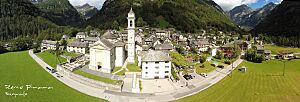Sonogno facts for kids
Quick facts for kids
Sonogno
|
||
|---|---|---|
 |
||
|
||
| Country | Switzerland | |
| Canton | Ticino | |
| District | Locarno | |
| Area | ||
| • Total | 37.52 km2 (14.49 sq mi) | |
| Elevation | 919 m (3,015 ft) | |
| Population
(December 2019)
|
||
| • Total | 82 | |
| • Density | 2.186/km2 (5.66/sq mi) | |
| Postal code |
6637
|
|
| Surrounded by | Brione (Verzasca), Chironico, Frasco, Gerra (Verzasca), Lavizzara | |
Sonogno is a small village in the Ticino region of Switzerland. It's located in a beautiful area called Valle Verzasca. Sonogno used to be its own town, but on October 17, 2020, it joined with other nearby towns like Vogorno, Corippo, Brione (Verzasca), and Frasco to form a new, larger town called Verzasca.
Contents
A Look Back in Time
Sonogno was first mentioned way back in the year 1200. For a long time, it was part of a bigger community in the Verzasca Valley. From 1395 to 1843, Sonogno and the nearby village of Frasco were actually one community.
The village got its own church in 1734, called St. Maria Loreto. This church was rebuilt in 1854 and has beautiful paintings inside by an artist named Cherubino Patà.
For many years, people in Sonogno mostly made a living by raising animals like cows. In the summer, the cows would graze high up in the mountains. In winter, they were moved to warmer areas. Because there weren't many jobs, many people from Sonogno moved away, especially after 1850. You can find people whose families came from Sonogno in almost 40 different countries today! This movement of people has caused the village's population to get smaller over time. In 1974, the Museum of Verzasca was opened in Sonogno, which tells the story of the valley.
Where is Sonogno?
Sonogno is located in the Locarno area. It's the last village you reach on the paved road through the Verzasca Valley. If you visit, you'll need to park your car at the entrance to the village, as vehicles aren't allowed inside. The village sits at an elevation of about 918 meters (3,012 feet) above sea level. It's about 30 kilometers (19 miles) away from the larger town of Locarno.
The land around Sonogno is mostly covered by forests (about 27.4%). A smaller part (1.1%) is used for farming. A large portion, about 52.5%, is unproductive land, meaning it's too rocky or has too little soil for plants to grow easily.
Village Symbol
The symbol, or coat of arms, for Sonogno shows a black chamois (a type of goat-antelope) standing. Below it are three blue stars.
Who Lives in Sonogno?
In 2019, Sonogno had a population of 82 people. Most people in Sonogno speak Italian, which is the main language in this part of Switzerland. A few people also speak German or French.
The population has slowly decreased over the years. In 1850, there were 334 people, but by 2000, it was down to 86.
What to See
The entire village of Sonogno is considered a special historical site in Switzerland. This means its traditional buildings and layout are protected because they are important to Swiss heritage.
How People Work
In 2005, a large part of the jobs in Sonogno (47%) were still in farming. There are also businesses in the service sector, like hotels and shops. In 2009, there was one hotel in Sonogno. Most people who work in Sonogno either walk or use a private car to get to their jobs.
Religion
Most people in Sonogno are Roman Catholic. A small number belong to other churches.
Weather in Sonogno
Sonogno gets a lot of rain or snow, averaging about 108 days of precipitation each year. The wettest month is September, and the driest is December.
Learning and Schools
In Switzerland, most people are well-educated. In Sonogno, many adults have completed higher education.
For younger students, there is kindergarten for children aged 0-9. After that, students attend primary school for five years. For middle school, students can choose between a two-year program or a four-year program that prepares them for higher education. There are also options for vocational training, where students learn a trade while working.
See also
 In Spanish: Sonogno para niños
In Spanish: Sonogno para niños








